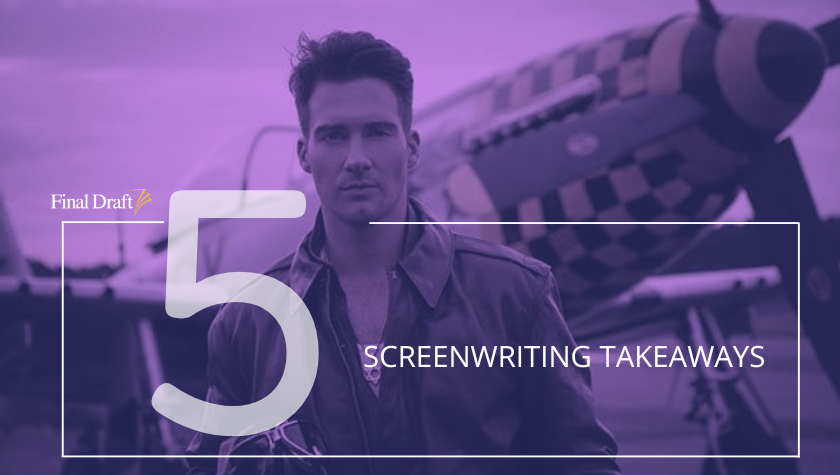Take 5: ‘Devotion’ and the art of adapting a true story
November 27, 2022
Devotion takes place in 1950 at the beginning of the Korean conflict, also known as the ‘Forgotten War.’ In some ways this is true. Rare is the movie that highlights this tumultuous time in our history with the most recognizable example being M*A*S*H*. Devotion is a film that follows the first African American pilot in the United States Navy and the wingman he flies with amid the increasing conflict on the Korean peninsula. For the Jesse Brown, played by Jonathan Majors, his ascent to getting his wings was filled with systemic racism, which plays a factor in who he trusts and how he handles himself with the continued abuse.
For writers looking to create their own historical film, here are five screenwriting takeaways you can learn from Devotion.
- Building a World with Historical Context
One of the benefits of creating a historical narrative is the ability to take the audience back to a world before their time. In Devotion, the audience gets a glimpse of life as a Naval aviator during the escalation of the Korean War as well as how different races are treated both in the United States and abroad.
Building this world involves knowing what planes the aviators flew in, where they bunked and the attitudes toward racial progress during the time. There is also a matter of a major world war concluding a few years prior and the establishment of an integrated armed forces.
All of these factors play a part in how the characters act in the situation they’re in and how they view their purpose in life. If you’re writing a story that is historically-based, you’ll have to find ways to realistically portray what that time was like and how the characters would act and react true to that time period.
- Writing from the Original Source Material
Devotion is based on the book written by Adam Makos. Within the book, Makos shares the histories of the two aviators from their early life. In the film version, there is nothing. And that’s not the only thing that didn’t make it when adapting the book into a major motion picture.
Writers Jake Crane and Jonathan Stewart had the task of taking a 460+ page book and turning it into a story that fits a 2 hour and 18-minute narrative. Not only does this involve removing considerable amounts of the original source material, it also means adding content that fits into how they want to tell this story on the screen.
The process involves combining characters, adding new scenes and making up dialogue. When you write a screenplay based off a true story, you have to make it your own. This means ensuring it has your voice in the writing and allowing for creative licenses to add and change parts of the story to fit the narrative of the story you want to tell. Other recent examples include Thirteen Lives and The Eyes of Tammy Faye.
- Contrast the Two Lead Characters
One aspect that makes stories compelling is how two people seemingly with nothing in common can find a way to come together. While Jesse Brown and Tom Hudner (Glen Powell) are never enemies and both have a cordial relationship from the beginning, they are vastly different people coming from different backgrounds.
It’s similar to real life and how two people may become friends even if they are completely different people. What you can do is magnify the differences and create them as both character traits and context for their actions.
In Devotion, Brown is the first African American pilot who has been through extremely tough times as he battled racism in a recently integrated military. He’s a loner in the group, he doesn’t drink, and he’s married. This is all vastly different to Hudner who is much friendlier amongst the group, went to excellent schools and isn’t attached to anyone romantically.
In a movie where everyone on the surface is the same – all highly-skilled pilots who have been through intense training – it’s important that you build the character through their background.
- Facing External Conflicts
Your characters are going to face some external conflicts. What’s important is that the degrees in which they have to face these external battles vary in their scope. In Devotion, Brown faces many conflicts that challenge him and his abilities.
In a large, looming scope there is the Korean War and the communist push into the southern half of the peninsula. This means that Brown and his fellow pilots are heading into an active war zone – the first one since the end of World War II where they will fight capable enemies.
A different external conflict is continuous racism. Not only is Brown haunted by how he was treated, there is also unfriendly neighbors who are quick to call the police and a group of Army soldiers on their ship that make their racist views heard.
Both of these conflicts, as examples, challenge the hero of the story and he has to deal with them in different ways. He can shoot and bomb the enemy, but he can’t do the same while on the ship to those bullying him.
When you create a character you love, it’s hard to put them through hard times. However, that’s what you need to do for the audience to want to get behind them. In Devotion, you can see how Brown is constantly having to battle unending external conflicts – it only makes the viewer want to see them succeed more.
- The Final Climatic Scene
What’s an action movie without the final climatic scene? Whether it’s an action film like Top Gun: Maverick or a war movie loosely based on a true story like Saving Private Ryan, there is always a final battle that tests the merits of the protagonist.
Devotion offers a great example on what it means to rise to the occasion amid all the pain and strife that preceded the final scene. Not only are these scenes exciting but the audience is invested in the outcome. If you set up the characters, stakes and situation leading up to the final climatic scene then the viewer will be satisfied in the outcome.
Why do we care so much about the team sent to save Private Ryan in Saving Private Ryan? Because we’ve spent two hours getting to know them, living through the pain of losing friends, learning about their lives back home and knowing what they’re capable of when bullets start to fly. The audience is invested.
The final scene can’t live on its excitement on its own. You must ensure that the viewers want to go along for the ride alongside your characters.
Devotion stars Jonathan Majors and Glen Powell. This film was written by Jake Crane and Jonathan Stewart based on the book by Adam Makos. Devotion was directed by J.D. Dillard.
Written by: Steven Hartman
Steven Hartman is an award-winning, optioned screenwriter. He was a Top 5 Finalist in Big Break’s Historical Category in 2019 and won Best Action/Adventure in Script Summit’s Screenplay Competition in 2021. He holds a Bachelor of Arts degree from Columbia College and had internships at Jerry Bruckheimer Films and Village Roadshow Pictures. Steve is a full-time writer and creative video producer by day and a screenwriter and novelist by night.- Topics:
- Screenwriting & Craft




